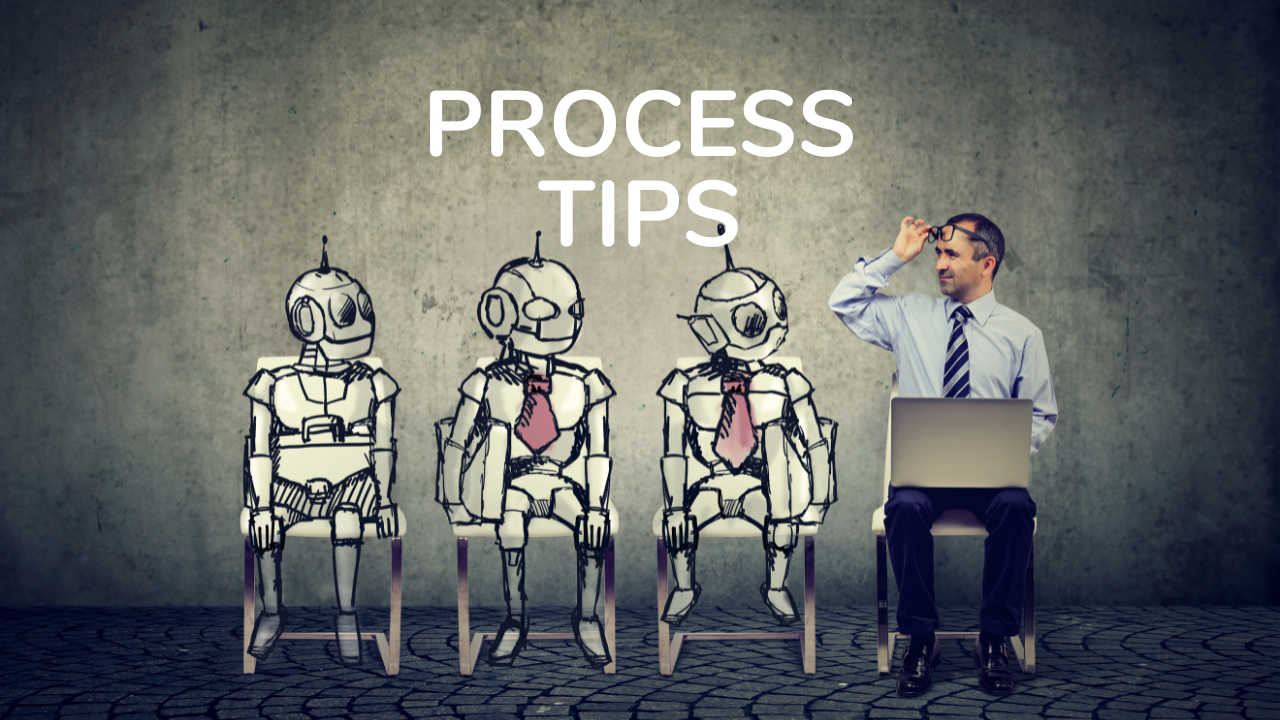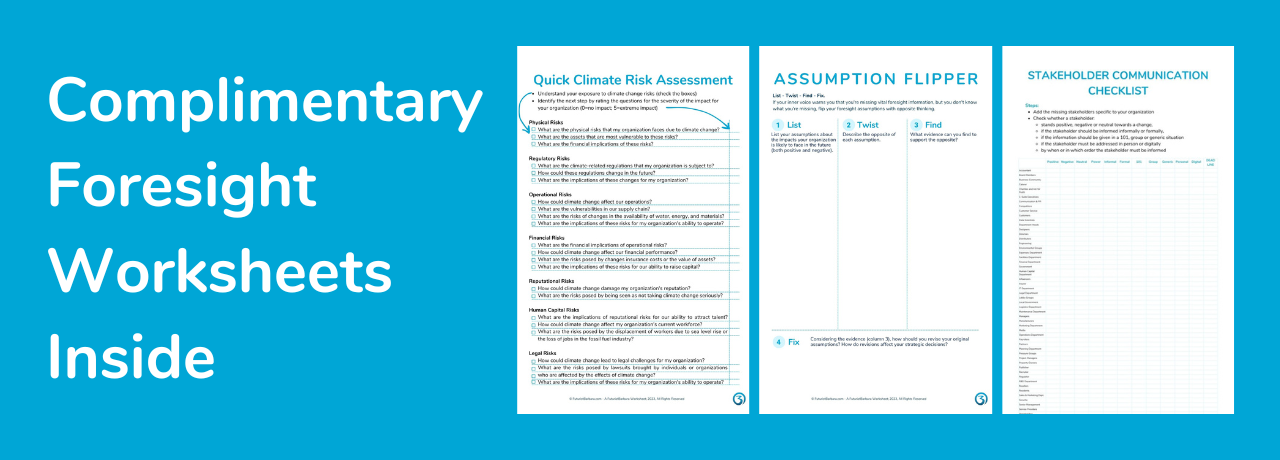
In July 2023, I analyzed 50 search results on the topic of foresight. Based on my analysis, I have identified 20 good tips for executives. I wanted to know more about what consultants are likely to tell you about foresight. I'm guessing that their tips come from an assumption about their customers needs (you). But assumptions aren't always right. I looked for the tips that were most and least frequently given. Here's what i found out. Plus, of course, my advise on what I think you should know ;)
The tips can be grouped into two categories:
- Process-oriented tips focus on the steps involved in the foresight process, such as identifying key drivers of change, scanning the environment for signals of change, and developing future scenarios.
- Challenge-oriented tips focus on the challenges and opportunities that businesses face in the future, such as the impact of climate change, the implications of new technologies, and the need to be prepared for disruption.
And guess what. One category outperformed the other: there was a huge difference in tip popularity. One category got thousands of views per day on average, and the other almost none. Can you guess which category was most popular? And what that means?
(I'll give you the answer at the bottom of the post)
But first... the tips:

Process-oriented tips:
Tip #1: Know Your Enemy: Identify the Key Drivers of Change
The first step to foresight is to understand the forces that are driving change in your industry and the world. This includes demographic trends, technological advances, political and economic changes, and social and cultural shifts.
How to get started: Set up a Google Alert for terms related to your industry and the future. This will help you to stay up-to-date on the latest trends and developments.
Tip #2: Pay Attention to the Clues: Scan the Environment for Change Signals
Once you have identified the key drivers of change, you need to scan the environment for signals that these drivers are starting to take effect. This includes new products and services being launched, changes in customer behavior, and regulatory changes.
How to get started: Subscribe to industry publications and attend industry events. When you read or go to a conference, focus deliberately on clues. This focus will help you to stay connected to the latest developments in your industry. You'll be amazed by the number of clues that otherwise would have remained undetected. (Framing your mind is such a handy tool).
Tip #3: Develop Future Scenarios
Once you have identified the key drivers of change and scanned the environment for change signals, you must develop future scenarios. This involves imagining different possible futures and the implications of these futures for your business.
How to get started: Brainstorm with your team about different possible futures for your industry. This will help you to generate a range of ideas to consider.
Tip #4: Assess the Impact of Change on Your Organization: Understand Risks and Opportunities
Once you have developed scenarios of the future, you need to assess the impact of these scenarios on your organization. This involves identifying the risks and opportunities that each scenario presents for your business.
How to do it: Conduct a SWOT analysis for each scenario.
Tip #5: Develop Strategies to Adapt to Change and be Prepared for Anything
Once you have assessed the impact of change on your business, you must develop strategies to deal with the impacts. This involves developing plans to mitigate the risks and capitalize on the opportunities that each scenario presents.
How to get started: Identify one key risk or opportunity your organization faces and develop a plan to address it.

Tip #6: Share the Vision: Communicate the Findings of your Foresight Work to Your Organization
Once you have developed strategies to adapt to change, you need to communicate the findings of your foresight work. This will help to ensure that everyone in your organization is aware of the challenges and opportunities that lie ahead and that they are working towards the same goals.
How to do it: Check off the checklist "Stakeholder Communication."
Tip #7: Be Prepared to Act on the Insights You Gain: Don't Just Sit Back and Wait
The final step in the foresight process is to be prepared to act on the insights you gain. This means changing your organization to adapt to the changing environment.
How to get started: Identify one small change you can make to your organization to adapt to change and implement it.
Tip #8: Be open to new ideas and perspectives.
The world is constantly changing, and organizations open to new ideas and perspectives are more likely to succeed.
How to get started: Create a challenge team: a group of trusted people from diverse backgrounds and different points of view that you can consult before high stake decisions.
Tip #9: Be Collaborative
In matters of foresight, one can succeed alone. Collaborative organizations are more likely to succeed because they can share ideas and resources with each other.
How to get started: Reach out to a member of your industry network that you admire and ask them to meet for coffee and a chat about their vision of the industry's future. Just see what happens and trust your entrepreneurial readiness to catch an opportunity when you hear it.
Tip #10: Be Patient
Change takes time. Patient organizations are not afraid to take risks and experiment because they have a long-term view. View the present as one step in a decade, and you'll see what I mean.
How to get started: Set one long-term goal for your organization and break it down into small, easy-to-achieve steps.

Challenge-oriented tips:
Tip #11. Consider the Impact of Climate Change on Your Organization
Climate change is a real and present threat to organizations of all sizes and sectors. It can cause physical damage to infrastructure, changes in demand, and increased costs (to name a few). Is your organization able to withstand these impacts? And how can it contribute to a solution?
How to get started: Do a quick climate risk assessment and take it from there (it takes about 30 minutes to insight).
Tip #12. Think About the Implications of New Technologies for Your Industry
New technologies are constantly emerging and can have a significant impact on businesses, both positive and negative. Executives need to be aware of the potential impacts of new tech to make informed decisions about how to adopt or adapt to it.
How to get started: Go to WIRED and read an article about a new technology that could impact your industry.
Tip #13. Pay Attention to Demographic Trends: The Future is Diverse
The world's population is becoming increasingly diverse, which is an opportunity. By embracing diversity, you can gain a competitive advantage, attract top talent, and create a more innovative workplace. But if your organization isn't happily diverse already, you must make it a part of the organizational culture. That takes time and thoughtful action.
How to get started: Look at the latest population data for your country or region and start by making your organization embrace the cultures that are already present in its context.
Tip #14. Consider the Impact of Globalization on Your Organization. The World is Your Oyster!
Globalization is a reality. To consider the impact of globalization, you can start by assessing current customer behaviors. When, how, and how much do your customers interact with other regions? What does that imply?
How to get started: Call a customer you know and ask them. Let yourself be inspired!
Tip #15. Be Aware of Political and Economic Changes that Could Affect Your Industry.
The political and economic landscape is constantly changing and sometimes even disrupting. Think Covid-19, the war in Ukraine, or the recent changes in US monetary policy. Are you aware of the political and economic changes closer to your organization's ecosystem?
How to get started: Subscribe to the newsletters by the Economist, the Financial Times, or Reuters and check their sites for background articles on political and economic changes.
Tip #16. Track Social and Cultural Trends: What's Hot, What's Not.
Social and cultural trends are constantly changing and lead to changes in demand. For instance, social media has changed how organizations interact with customers. Online shopping has changed the way we buy and sell. Do you know which new changes are emerging?
How to get started: Check what influencers are doing on social media. You can identify influencers by their high engagement stats (lots of likes, comments, and sharing action).
Tip #17. Understand the Emerging Needs and Expectations of Your Customers
Understanding emerging needs will help you improve customer satisfaction in the long run by identifying, developing, and testing new opportunities to serve them.
How to get started: Take a look at the new movie releases. They will reflect changes in the values and beliefs of society. Both blockbusters and arthouse movies illustrate these values and beliefs.
Tip #18. Be Prepared for Disruption
Disruption usually originates outside your focus. If it were in your focus, you would already be managing it. Besides, disruption stems from change and discontinuity, which can sneak up upon us almost imperceptibly. So, being prepared means shifting your focus regularly to the periphery and looking for the unfamiliar.
How to get started: Flip your assumptions and see where the opposite takes you. Don't worry; I've got a tool for that. The assumption flipper takes about 15 minutes to complete.
Tip #19. Be Willing to Experiment
Foresight is about looking at the future and imagining what it might hold. This means being willing to experiment with new ideas and approaches. Executives unwilling to experiment will be left behind by those who are. So answer this question: how willing is your organization really?
How to get started: Set an example :) Try new things, and celebrate both failures and successes.
Tip #20. Have a Plan for the Unexpected
Plans for the unexpected are specific. It may seem counterintuitive to have specific plans for the unexpected, but it is important to do so. The unexpected is often very specific because it is your organization that doesn't expect it. For example, if you are a business that relies on shipping, you should have a specific plan for what you will do if there is a shipping disruption. See what I mean?
How to get started: Identify the most important factors that your organization relies on and do a thought experiment. What if those factors are disrupted? How will you communicate with your customers, how will you deliver on your promises, and how will you minimize the impact?
The ten process tips and the ten tips to challenge you are here to help you create strategies and plans to make your organization more flexible and resilient. I hope you've found a few of them helpful!
By now, you must have an inkling which tips are more common. If only because you've heard them before. But to make sure: the process tips were way more common.
I am guessing that consultants who earn from process redesign are likely to focus on that part of the equation.
However, in my experience, organizations are super good at fixing and adjusting their processes because they know the intricacies like no consultant can. The best help they can get to start adjusting is a shared understanding of the need for process change. That understanding comes from the challenging questions. Which were much more fun anyway ;)
In any event (pun intended), wishing you a bright future!
PS. If you have tips, process or otherwise, please share them in the comments!
Fresh Foresight Insights Directly in Your Inbox
Join Barbara's mailing list to receive her latest Canary and updates about her research into managerial foresight and blind spots.
I hate SPAM too, so know that I won't spam or have others spam you!

